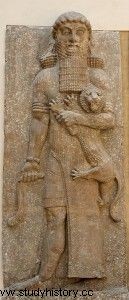

This text, one of the most ancient of mankind , tells us about the exploits of Gilgamesh, a hero of Sumerian mythology who ruled -according to the narration- in the city of Uruk around 2650 BC. In the fragments that are preserved, he tells us the epic story of the son of the goddess Ninsun and his particular odyssey to escape death .
Already in the year 2001 300 tablets were found with cuneiform texts. Some of them modified the ending what we knew about the story. Until then, the known version of the poem was extracted from a tablet found in 1853 in Nineveh.
The new fragment dates to the Neo-Babylonian period (around 2000-1500 BC). Although it does not add any new episode to the text that we knew, it unravels some mysteries that remained unsolved. These 20 lines correspond to the fifth chapter of the poem, specifically the episode in which Gilgamesh and his companion Enkidu kill Humbaba , the guardian monster of the Cedar Forest. This new director’s cut version of the scene grants moral nuances to the poem, showing Gilgamesh and Enkidu repentant for killing Humbaba, who has been dignified by giving him an appearance more in keeping with that of a king than a monster.
This new discovery demonstrates the existence of different versions of the poem, although there are still many of them to be discovered.
